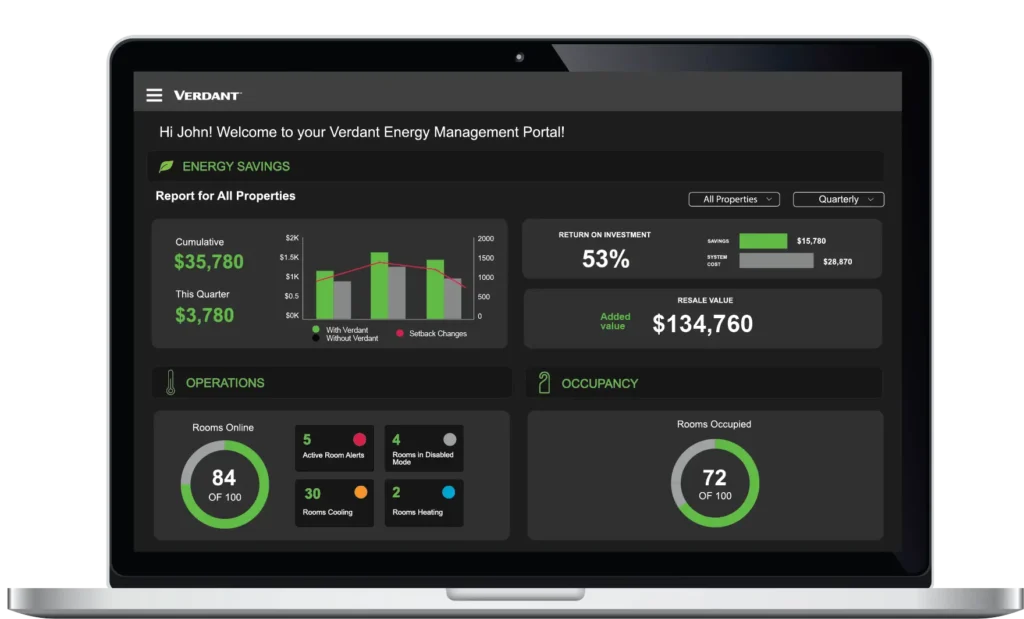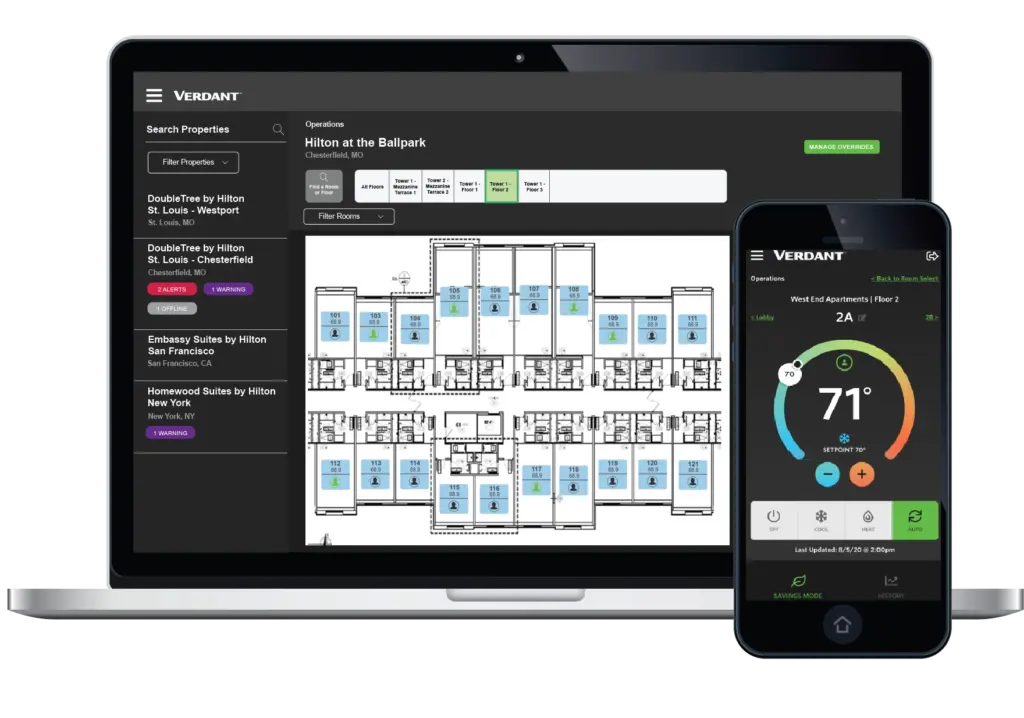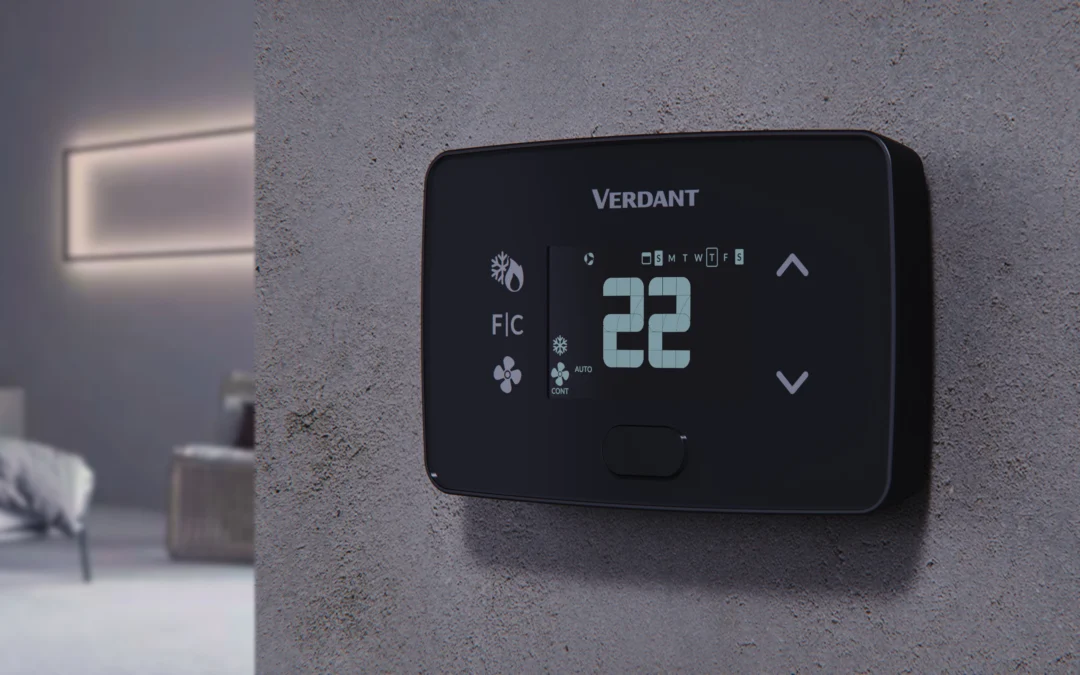How did energy management become so time-consuming? Over time, energy conservation has grown increasingly complex, with even the metrics themselves becoming more detailed.
There was a time when the simple Btu was being measured in the hundreds or thousands. But when the conversation is about saving energy, experts today are speaking in terms of quadrillion. That’s one thousand trillion, or about the same amount of energy in 45 million tons of coal. Last year, buildings in the residential and commercial sectors accounted for about 20.6 quadrillion Btu—about 30% of the United States’ total end-use energy consumption.
Energy efficiency often means thinking about more than just the energy itself. In the real world, property managers can’t help but also consider the more mundane factors of time and effort. Staff shortages and high turnover rates add to the existing obstacles.
But with over 9,000 installations in hotels, multifamily, senior living, and student housing properties under the Verdant belt, we provide an improved implementation of energy management through the following features.

1) Energy Management Profiles
No two buildings are alike. Every address has its own unique challenges to keeping the lights on, the temperatures comfortable and the amenities all powered up. It makes sense to consider each property as an individual personality with its own needs, temperament, and idiosyncrasies. And that means giving each property its own energy management profile.
Regardless of who pays for utilities, cutting waste, and saving money is the top priority. Verdant’s energy management solution keeps comfort in focus while allowing you to hone in on reducing costs. For instance, you can set specific temperature ranges to meet occupant needs, track ongoing energy usage and program unique temperature setbacks to help ensure the property’s overall energy wellness…all while sustaining comfort.
2) Occupancy Detection
Perhaps nothing wastes energy more egregiously than heating and cooling an empty space. Consider the average hotel: its rooms are unoccupied more than 60% of the time. The use of occupancy detection in these settings is critical for optimizing energy management.
Verdant smart thermostats can sense when guests have left their rooms, automatically kicking the energy management system into gear. The room automatically enters a setback mode allowing temperatures to drift naturally by a few degrees. It’s a simple tactic that can reduce HVAC runtimes by 40% on average.
Of course, the challenge for motion sensors is knowing the difference between an empty room and a room with sleeping guests. Use our proprietary Night Occupancy Mode to ensure them a snug and cozy night.
Verdant’s Night Occupancy Mode allows you to configure a daily time-period where guests’ preferred setpoints can be maintained during sleeping hours (for instance between 8pm-8am). There’s no way to spend less time making sure guests have the comfort they demand within a building effectively reducing energy waste.

3) Remote Control
Buildings should encourage their tenants to “move” into their unit’s smart thermostat. Because when residents take advantage of smart features like programming, remote control and flexible scheduling, they become part of your solution—helping you reduce their energy use for you.
It gets even better when residents embrace Verdant features such as geofencing. With geofencing activated in the Verdant app, the thermostat senses their smartphone to sense when residents are home or not, and then automatically adjusts the temperature up or down accordingly. Geofencing delivers the sort of convenience that helps bring tangible benefits to building operators with ESG standards to meet.
But there’s an even bigger plus: Instead of just the residents, now property managers, the maintenance staff, and engineering teams can also utilize the Verdant app to manage thermostats remotely. So you can take full remote control over individual thermostats or even a network of thermostats across multiple rooms or buildings as needed. It doesn’t get any easier than that.
4) Smart Alerts and Reminders
It’s too easy for operators to miss out on opportunities to save energy. Yet these days there are rarely enough hands-on-deck around to stay on top of every savings opportunity at every building. Property managers must find other, more reliable ways to track temperature changes, system disruptions and other issues that arise. There needs to be a simple way to stay alert.
Verdant Plus keeps operators in the know with automated Savings Alerts—real-time email notifications essential to improving energy efficiency and conservation at your properties. These alerts help you track and manage energy usage each month. They provide the critical notification you need to maximize your energy efficiency.
Savings Alerts are structured to quickly inform staff—escalating to trigger the critical actions required to save energy.
- Alert 1: Online Status: When your system is offline for more than two days or more.
- Alert 2: Optimal Savings Mode: When your daily energy saving levels decline below a certain threshold.
- Alert 3: Active Alerts: When our system identifies a surge in active alerts on your property.
5) Dynamic Recovery
There’s something very personal about one’s living space. Even if it’s for just a single night, we expect complete control over all that space’s amenities. That makes automatically setting back the temperature whenever guests leave their rooms a serious nuisance—especially if a room is uncomfortable when they return.
That’s what Verdant’s Dynamic Intelligent Recovery is all about.
Dynamic Intelligent Recovery is designed to ensure guests’ comfort so they be blissfully unaware of your property’s efforts to reach peak energy efficiency. Our secret is all in the math.
You see, Verdant thermostats are constantly calculating the slew rate of the HVAC unit—the amount of time required by that unit to heat or cool the room by a single degree. Using this information, the thermostat determines the maximum temperature setback possible and how long it will take to “recover” or return to the occupant’s setpoint.
Dynamic Intelligent Recovery is a clever and effortless technology allowing guests to feel genuinely pampered while your building is busy increasing its energy efficiency.
6) Multi-Profile Management
While installing a feature-rich energy management system or smart thermostat is the first step in saving energy, the system also needs to be configured properly for best results.
In fact, according to energy.gov, programming a thermostat to turn the temperature back just 7°-10°F from its normal setting for eight hours a day can save as much as 10% a year on heating and cooling bills. This may be the single easiest way to make a dent in one’s energy bill.
Better yet, with the savings comes heightened comfort and convenience. Verdant 7-day programmable thermostats make it simple to schedule temperature settings both right there on the wall or on the smart phone app in your hand. Either way, tenants setting personalized temperature schedules can program for each day of the week, the weekend and even their nightly sleep time. Along the way, they’ll enjoy optimal comfort and painless energy savings. When combined with geofencing, a programmed thermostat provides a great one-two punch for energy efficiency.
7) Demand Response Capability
Utility companies are eager to partner with customers to help share the burden of energy conservation. They’ll reward participants with worthwhile incentives. It’s all part of the demand response programs that are being offered across the nation.
By enrolling in a demand response program, customers agree to allow their utility partner to automatically adjust their thermostats up or down during periods of peak energy use. This helps stabilize the power grid, protecting the entire community against potential blackouts or brownouts and keeping costs down.
According to Statista, there were over 10 million people enrolled in demand response programs across the United States in 2022. Almost all of them were residential customers. The good news for property owners is that residential customers are showing a growing interest in participating in these programs.
Demand response programs are crucial to optimizing energy usage for today and in the future. Verdant smart thermostats are equipped for that capability. That’s good for residents. It’s good for the community. And it supports your ESG practices.
Demand response programs play a vital role in optimizing energy usage now and in the future. Verdant smart thermostats are designed to support these programs, benefiting residents, and providing support to your ESG objectives.
8) Energy Usage Reports
The more you know about your buildings’ HVAC performance, and the better you can track that data, the more successful you’ll be at reducing the financial impact of those very systems. You need to have in hand the most complete picture possible so you can identify issues requiring adjustment—and then take action.
Verdant puts that information right into your inbox with monthly Energy Usage Reports. You can also view that data in real-time on the Verdant app.
Each Usage Report delivers key information through simple, easy-to-read graphics. Icons show the number of hours your systems have run over a monthly period. You can view hourly heating/cooling runtimes and even compare them month-over-month. There’s no better way to have the clarity you need to make good energy decisions more efficiently.
Get a Quick Look at Success Stories
Gain insights, inspiration, and innovation from these success stories. You’ll get a detailed look at energy management in action in hospitality, senior living, multifamily, and student housing. You will also discover how data-driven insights, significant cost savings, and maximized energy efficiency can help you thrive.
Unlock Energy Savings at Your Property with Verdant!
Are you looking to make your property more energy-efficient and cut down on utility bills? Discover how our innovative solutions can help you achieve significant energy savings.

